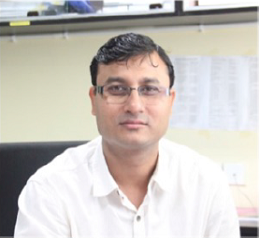Sanjay K Banerjee
National Institute of Pharmaceutical Research and Education, India
Title: A potential target for diabetic cardiomyopathy
Biography
Sanjay
Kumar Banerjee is an Associate Professor and In-Charge at National Institute of
Pharmaceutical Education and Research (NIPER), Guwahati, Assam, India. He
completed, his PhD in Pharmacology from All India Institute of Medical Sciences,
India. His research goal is to identifying and validating novel targets and
therapeutic intervention for cardiovascular and metabolic disorders. His
laboratory is mostly interested to understand molecular mechanisms of insulin
resistance and cardiac complication in diabetes, and identify nutritional
agents/natural products to reduce the disease progression. Overall goal is to
bridge the gap between observations in the basic research laboratory and the
clinical bedside. Sanjay K Banerjee studies will be an integral part in
‘‘translating’’ new discoveries into therapeutic initiatives.
Abstract
Several targets are
being explored to reduce cardiac disorder in diabetes. Sirtuins, a group of
deacetylases, are potential targets that can regulate cellular metabolism,
oxidative stress, and mitochondrial health. Data showed that sirtuins,
specially Sirt1 and Sirt3 activation can prevent or reverse the progression of
several chronic metabolic diseases through the regulation of multiple histone
and non-histone proteins. In the present study, we aimed to evaluate the effect
of Sirt1, Sirt3 and combined activation in high fructose diet-induced insulin
resistance rat heart and assessed the cardiac function focusing on
mitochondrial health and function. We administered the Sirt1 activator; SRT1720
(5mg/kg, i.p.), Sirt3 activator; Oroxylin-A (10 mg/kg i.p.) and the combination;
SRT1720+Oroxylin-A (5mg/kg and 10 mg/kg i.p.) daily from 12th week to 2oth weeks
of study. We observed significant perturbations of most of the cardiac
structural and functional parameters in high fructose diet-fed animals.
Administration of SRT1720 and Oroxylin-A improved perturbed cardiac structural
and functional parameters by decreasing insulin resistance, oxidative stress,
and improving mitochondrial function by enhancing mitochondrial biogenesis,
OXPHOS expression and activity in high fructose diet-induced insulin-resistant
rats. However, we could not observe the synergistic effect of SRT1720 and
Oroxylin-A combination. Similar to in-vivo study, perturbed mitochondrial function
and oxidative stress observed in insulin resistant H9c2 cells were improved
after activation of Sirt1 and Sirt3. We observed that Sirt1 activation enhances
Sirt3 expression and mitochondrial biogenesis, and the opposite effects were observed
after Sirt1 inhibition in cardiomyoblast cells. Taken together our results
conclude that activation of Sirt1 alone could be a potential therapeutic target
for diabetes-associated cardiac complications.
 24-25 Mar 2021
24-25 Mar 2021  Webinar | Online | 11:00-17:00 GMT
Webinar | Online | 11:00-17:00 GMT 
